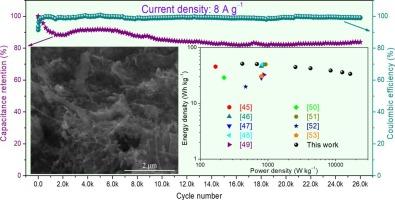还原氧化石墨烯与碳纳米纤维协同优化混合超级电容器NiS2/CoNi2S4异质结构储能性能
IF 5.1
3区 材料科学
Q2 MATERIALS SCIENCE, COATINGS & FILMS
引用次数: 0
摘要
开发优良的电极材料一直是推动清洁和可再生能源高性能储能装置广泛应用的不懈追求之一。本工作通过简单的水热途径引入碳纳米纤维(CNFs)和还原氧化石墨烯(RGO)纳米片协同优化NiS2/CoNi2S4异质结构,合理设计了一种新型纳米复合材料(NiS2/CoNi2S4/RGO/CNFs,表示为NCNS@R/C)。由于具有高电导率和高比表面积的CNFs和还原氧化石墨烯共同构建了层次化的多孔网络纳米结构,这不仅有助于获得优异的电荷传输和离子扩散动力学,而且还促进了所生成的分散锚定的NiS2/CoNi2S4纳米颗粒呈现丰富的暴露电活性位点。因此,NCNS@R/C电极比NCNS@R和NCNS@C电极具有更好的储能性能,包括在0.8 A g−1时高达1577.7 F g−1的高比电容和优异的倍率性能(77.1%,0.8→20 A g−1)。令人兴奋的是,所设计的NCNS@R/C//AC混合超级电容器在功率密度为418.3 W kg - 1时具有51.4 Wh kg - 1的能量密度和超长循环耐久性,在26,000次循环后具有83.78%的电容保留率。结果表明,NCNS@R/C纳米复合材料具有优异的电化学储能性能,在低成本、长寿命、高效率的混合超级电容器中具有良好的应用潜力。本文章由计算机程序翻译,如有差异,请以英文原文为准。

Improved energy storage performance of NiS2/CoNi2S4 heterostructure with reduced graphene oxide and carbon nanofiber synergistic optimization for hybrid supercapacitor
Developing excellent electrode materials have been one of the unremitting pursuits to promote the widespread application of high-performance energy storage devices for clean and renewable energy. This work rationally designed a novel nanocomposite (NiS2/CoNi2S4/RGO/CNFs, denoted as NCNS@R/C) by introducing carbon nanofibers (CNFs) and reduced graphene oxide (RGO) nanosheets to synergistically optimize NiS2/CoNi2S4 heterostructure via a simple hydrothermal route. Owing to the CNFs and RGO with high conductivity and high specific surface area co-construct hierarchical porous network nanostructures, which not only helps to obtain excellent charge transport and ion diffusion kinetics, but also promotes the generated dispersion-anchored NiS2/CoNi2S4 nanoparticles to present abundant exposed electroactive sites. Consequently, the NCNS@R/C electrode exhibits superior energy storage properties than the NCNS@R and NCNS@C electrodes, including high specific capacitance of 1577.7 F g−1 at 0.8 A g−1 and excellent rate performance (77.1 %, 0.8 → 20 A g−1). Excitingly, the designed NCNS@R/C//AC hybrid supercapacitor exhibits a promising energy density of 51.4 Wh kg−1 at power density of 418.3 W kg−1 and an ultra-long cycle durability with 83.78 % capacitance retention after 26,000 cycles. These results demonstrate that the NCNS@R/C nanocomposite exhibits excellent electrochemical energy storage performance, and shows good application potential in low-cost, long-life and high-efficiency hybrid supercapacitors.
求助全文
通过发布文献求助,成功后即可免费获取论文全文。
去求助
来源期刊

Diamond and Related Materials
工程技术-材料科学:综合
CiteScore
6.00
自引率
14.60%
发文量
702
审稿时长
2.1 months
期刊介绍:
DRM is a leading international journal that publishes new fundamental and applied research on all forms of diamond, the integration of diamond with other advanced materials and development of technologies exploiting diamond. The synthesis, characterization and processing of single crystal diamond, polycrystalline films, nanodiamond powders and heterostructures with other advanced materials are encouraged topics for technical and review articles. In addition to diamond, the journal publishes manuscripts on the synthesis, characterization and application of other related materials including diamond-like carbons, carbon nanotubes, graphene, and boron and carbon nitrides. Articles are sought on the chemical functionalization of diamond and related materials as well as their use in electrochemistry, energy storage and conversion, chemical and biological sensing, imaging, thermal management, photonic and quantum applications, electron emission and electronic devices.
The International Conference on Diamond and Carbon Materials has evolved into the largest and most well attended forum in the field of diamond, providing a forum to showcase the latest results in the science and technology of diamond and other carbon materials such as carbon nanotubes, graphene, and diamond-like carbon. Run annually in association with Diamond and Related Materials the conference provides junior and established researchers the opportunity to exchange the latest results ranging from fundamental physical and chemical concepts to applied research focusing on the next generation carbon-based devices.
 求助内容:
求助内容: 应助结果提醒方式:
应助结果提醒方式:


